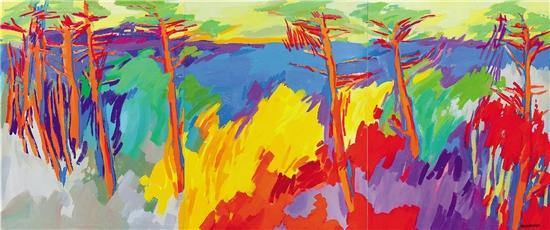
在艺术世界中,一提起晨晓这个名字,往往离不开他笔下那丰富的色彩。高饱和度、符号化的作品,为他在西方开拓了一片天地。旅居国外30多年后的他,跨越半个地球,从新西兰回到故乡诸暨。绅士帽,红毛衣,50多岁的艺术家晨晓,依然活力满满。
In the world of art, the name of Sean Chen usually reminds people of the rich colors. Works highly saturated and symbolized have endowed him with a reputation in the western countries. After staying abroad for 30 years, he came back to his hometown Zhuji from New Zealand. In a fedora hat and a red sweater, Sean Chen, though in his fifties, looks young and georgeous.
色彩是晨晓作品中最大的特征,但很多人不知道,其实他患有色弱,对颜色的辨别能力和大多数人不一样。
The most outstanding characteristic of Sean's works is the colors. It is rarely known that he suffers from color weakness. He identifies colors in a way different from most of us.
晨晓说,“我看到的色彩肯定和你看到的不一样,但我知道在你眼里是什么颜色。”
As Sean Chen said, "The colors in my eyes are different from those in yours, but I know what they look like in your eyes."
30多年前的他,为此迷茫了很久。1986年,怀揣着100美元、几乎一句英文都不会讲的晨晓,踏上了澳大利亚的土地,后又辗转到了新西兰。他在街头用国内当时流行的线描画为游人画肖像,几天下来却无人问津,后来才知道,那时候的澳洲人喜欢的是素描。这个经历打开了他的作画思维。他开始用色彩找到来自东方的独特内核:用“你”理解的方式去描绘“我”的故事。中西方艺术在他的色彩里融为一体,风格越来越鲜明,艺术成果也越来越多,在多个西方国家举办过作品展。
30 years ago, Sean Chen was confused by his color weakness problem. In 1986, he went to Australia with only USD 100 in pocket and little knowledge of English, and made his way to New Zealand later. On the street, he tried to draw portraits for tourists in line sketch, which was popular in China at that time. However, no one was attracted back then. He realized the Australians at that time preferred pencil sketch. This inspired him. He began to explore the oriental uniqueness with colors: drawing "my" story in "your" perspective. By integarting Chinese and western arts with colors, he developed an distinctive style of his own, gaining more artistic recognition. His works have been exhibited in many western countries.
走得再远,成就再高,他也放不下家乡。去年10月,晨晓婉拒国内多所名牌高校的邀请,回到家乡,出任浙江农林大学暨阳学院晨晓艺术与设计学院院长。不久后,他和学院接到的第一个“活”,就是山下湖镇大地艺术乡村旅游规划设计项目。
In spite of the increasingly good reputation, he still misses his hometown. Last October, Sean Chen, declining invitations from many prestigious universities in China, returned to his hometown, and took up the post as the dean of Sean Chen Art and Design School of Jiyang College of Zhejiang A&F University. Soon after, a project came for him -- to plan and design the Land Art Countryside Tourism Project of Shanxiahu Town.
自从承接山下湖镇的项目后,在村子里转一转,到村民家串串门,就成了晨晓的日常。如今,哪几栋房子旁边有池塘、哪个路口有荒地,他都了如指掌。如果可能,他还想了解这里的每一方池塘、每一片田地和每一个人。这样,画在这片土地上的色彩才会有它独特的个性和灵魂。
Undertaking the project, Sean Chen became a frequent visitor to the village. Now, he knows quite well which buildings have pools nearby and which intersections have wasteland around. If possible, he would like to know all the ponds, fields and people here. He believed that would make the colors for this land more unique and connotative.
一说起山下湖,很多人脑中浮现的肯定是珍珠。在最初设计色彩时,晨晓融入最多的,就是珍珠的色、质、形,比如,晶莹透亮的珍珠雕塑,亮眼夺目的标志景观等。但他的色彩设计中,还多了一抹乡情。游历过60多个国家的晨晓,把心底溢出的情感,投射在多达几百张的色彩设计稿上。
When talking about Shanxiahu, pearls would come into the minds. In initial color design, what Sean Chen adopted the most were the color, texture and form of pearls, such as the glittering and translucent pearl sculpture and eye-dazzling symbolic landscape. He also incorporated his love for his hometown in it. Sean Chen, a traveler to more than 60 countries, projected his overflowing love on the color design drafts up to several hundreds of pieces.
今年大年初四,晨晓游山下湖,屋前的红灯笼、空气中弥漫的饭菜香、耳边传来的欢声笑语,让刚从新西兰回国的他仿佛回到了儿时。这种体会,也让他对自己起草的策划方案有了更深的感悟。“我希望可以用色彩画出儿时的快乐,画出一种能在山下湖寻找到的乡情。”
On the fourth day of the first lunar year, Sean Chen toured Shanxiahu, where the red lanterns hanging in front of each house, food fragrance in the air, and laughs and cheers around his ears brought the returner to his childhood. This feeling also deepened his perception about the planning scheme. "I hope to draw my childhood happiness with colors and show the unique country life in Shanxihu."
(Executive Editor: Yongliu HE)